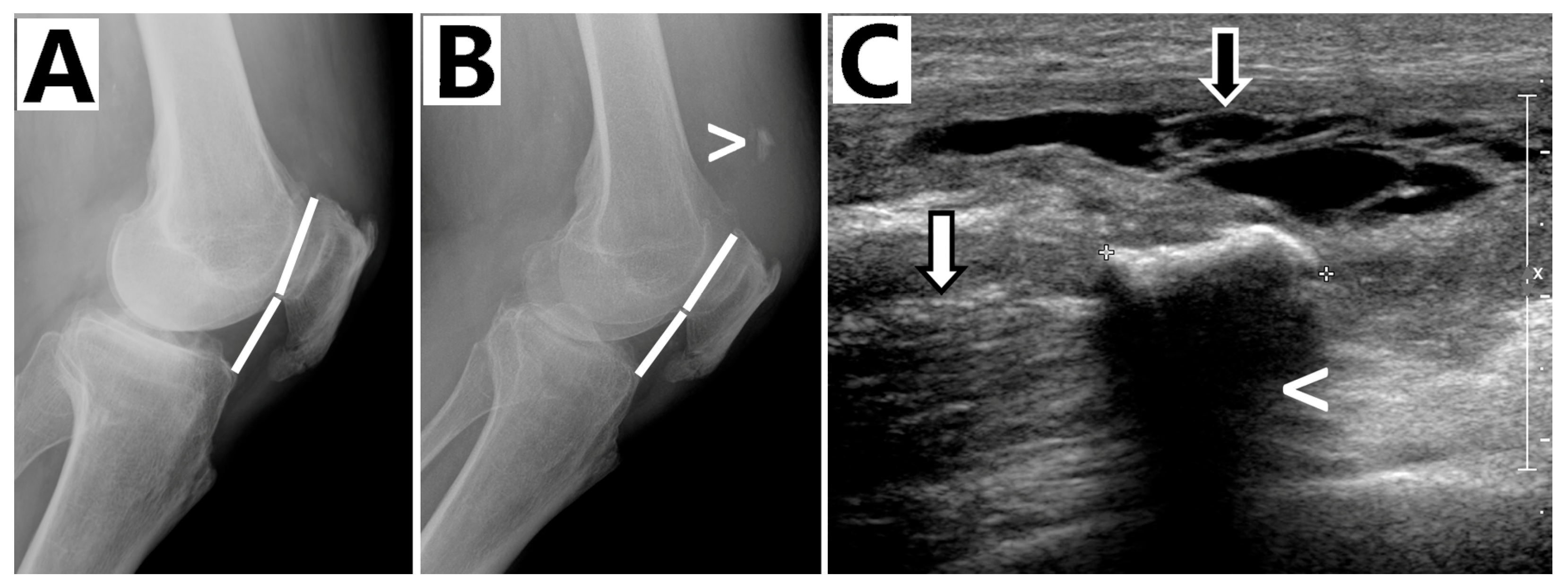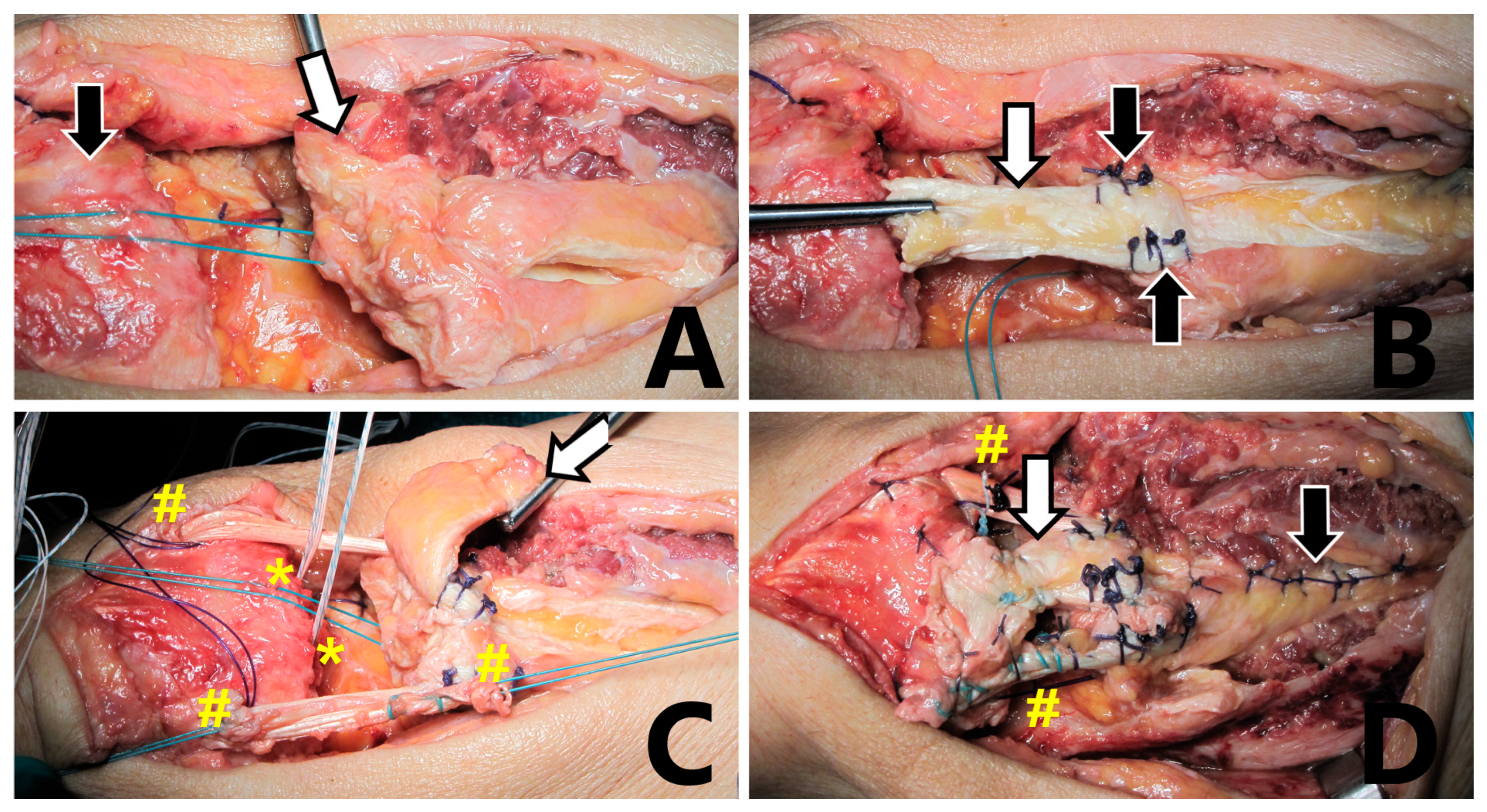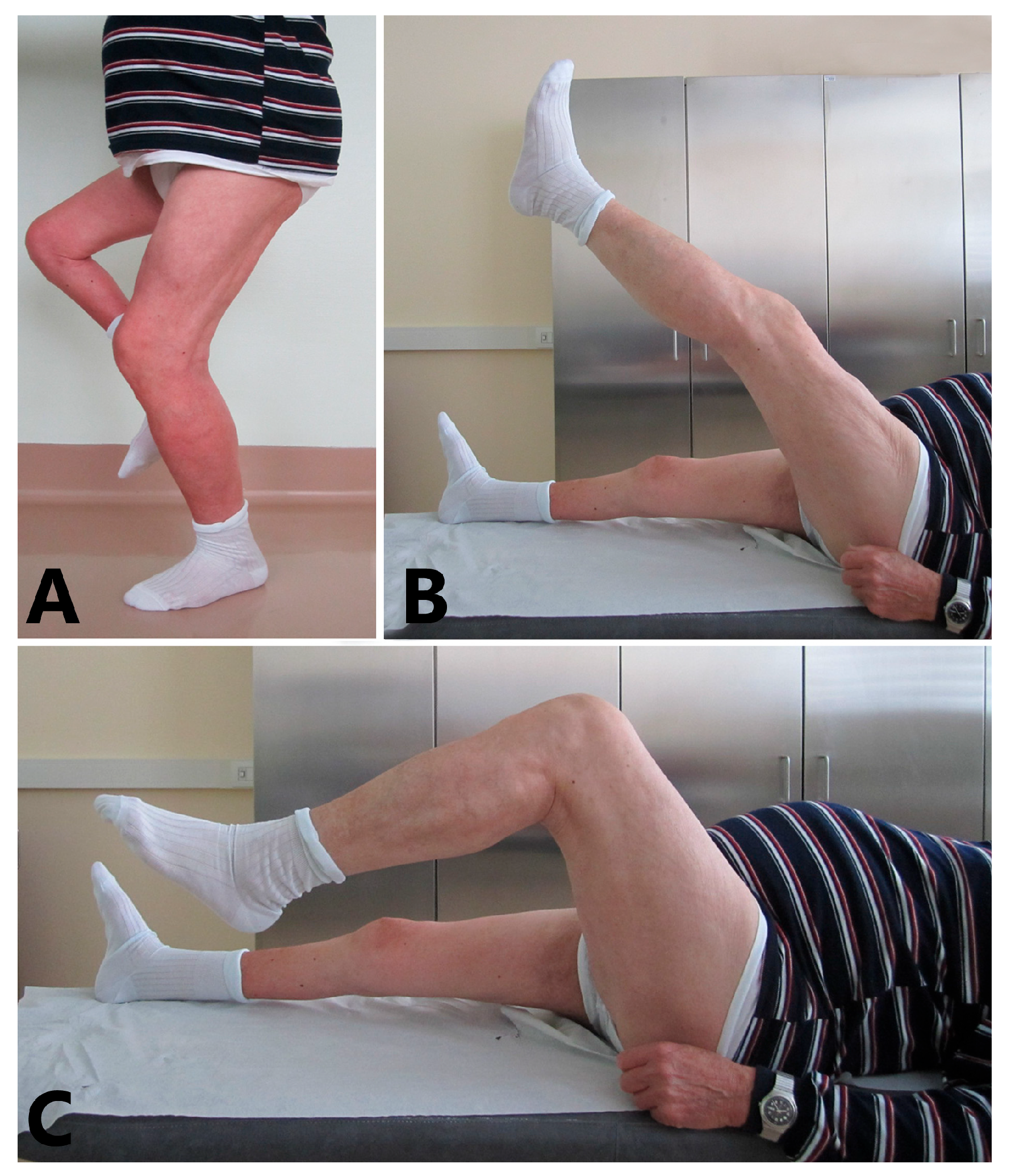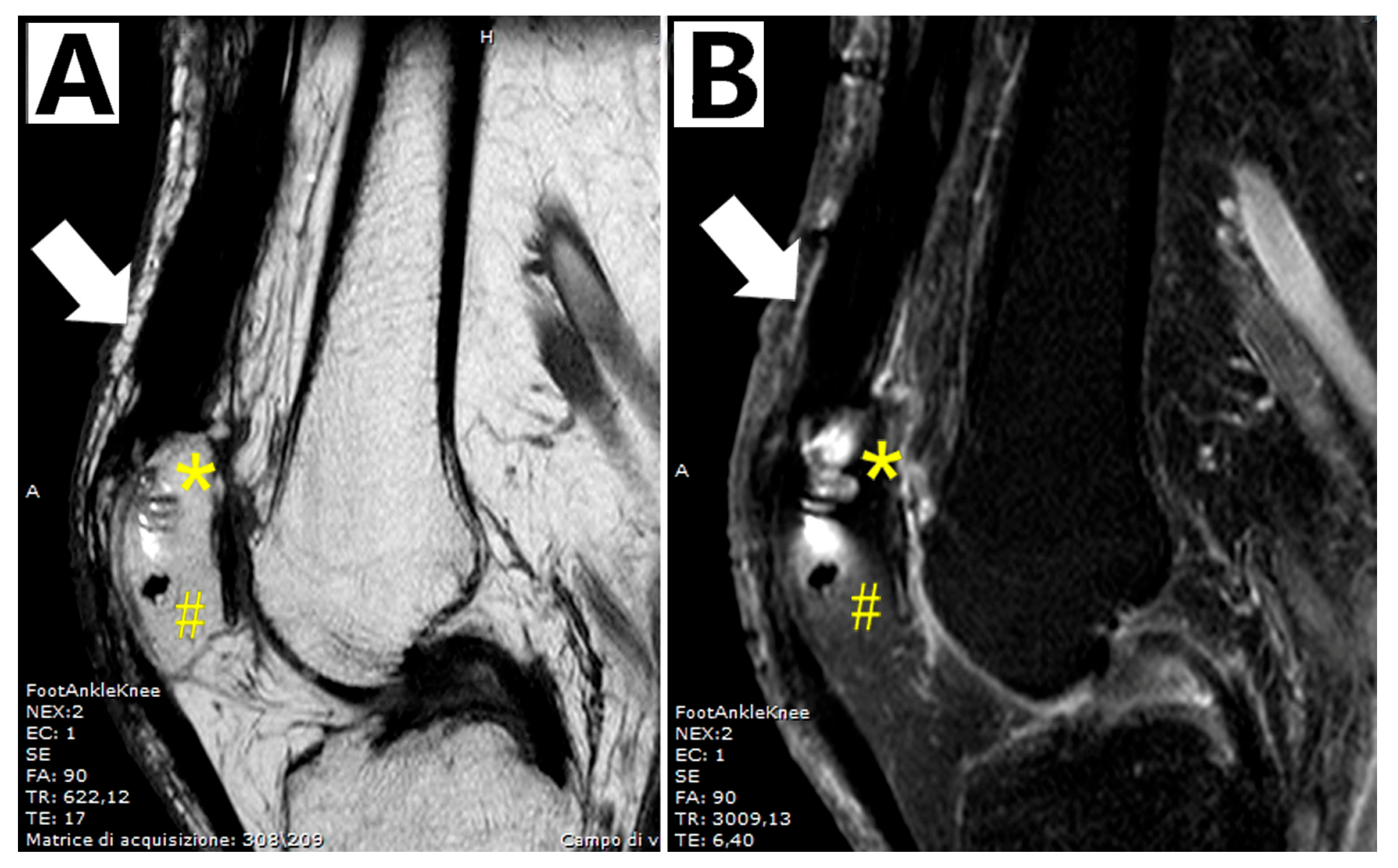Reconstruction of a Chronic Quadriceps Tendon Rupture in an Elderly Polio Patient
Abstract
1. Introduction
2. Case Report
3. Surgical Technique
4. Discussion
Author Contributions
Funding
Institutional Review Board Statement
Informed Consent Statement
Data Availability Statement
Conflicts of Interest
References
- Elattar, O.; McBeth, Z.; Curry, E.J.; Parisien, R.L.; Galvin, J.W.; Li, X. Management of Chronic Quadriceps Tendon Rupture: A Critical Analysis Review. JBJS Rev. 2021, 9, e20. [Google Scholar] [CrossRef] [PubMed]
- Oliva, F.; Marsilio, E.; Migliorini, F.; Maffulli, N. Complex Ruptures of the Quadriceps Tendon: A Systematic Review of Surgical Procedures and Outcomes. J. Orthop. Surg. Res. 2021, 16, 547. [Google Scholar] [CrossRef] [PubMed]
- Palmeri, S.; Guelfi, M.; Corsini, A. Sports medicine group siagascot Comprehensive Management of Lower Limb Tendinopathies in Athletes: Advances and Challenges. Joints 2024, 2, e931. [Google Scholar]
- Neubauer, T.; Wagner, M.; Potschka, T.; Riedl, M. Bilateral, Simultaneous Rupture of the Quadriceps Tendon: A Diagnostic Pitfall? Rort of Three Cases and Meta-Analysis of the Literature. Knee Surg. Sports Traumatol. Arthrosc. 2007, 15, 43–53. [Google Scholar] [CrossRef] [PubMed]
- Kerin, C.; Hopgood, P.; Banks, A.J. Delayed Repair of the Quadriceps Using the Mitek Anchor System: A Case Report and Review of the Literature. Knee 2006, 13, 161–163. [Google Scholar] [CrossRef] [PubMed]
- Rehman, H.; Kovacs, P. Quadriceps Tendon Repair Using Hamstring, Prolene Mesh and Autologous Conditioned Plasma Augmentation. A Novel Technique for Repair of Chronic Quadriceps Tendon Rupture. Knee 2015, 22, 664–668. [Google Scholar] [CrossRef] [PubMed]
- Joseph, B.; Watts, H. Polio Revisited: Reviving Knowledge and Skills to Meet the Challenge of Resurgence. J. Child. Orthop. 2015, 9, 325–338. [Google Scholar] [CrossRef] [PubMed]
- McCluskey, D. Aids to the Examination of the Peripheral Nervous System. Ulst. Med. J. 1989, 201, 58. [Google Scholar]
- Scuderi, C. Ruptures of the Quadriceps Tendon. Study of Twenty Tendon Ruptures. Am. J. Surg. 1958, 95, 626–635. [Google Scholar] [CrossRef] [PubMed]
- Oliva, F.; Marsilio, E.; Migliorini, F.; Maffulli, N. Chronic Quadriceps Tendon Rupture: Quadriceps Tendon Reconstruction Using Ipsilateral Semitendinosus Tendon Graft. J. Orthop. Surg. Res. 2023, 18, 355. [Google Scholar] [CrossRef] [PubMed]
- Gulotta, L.V.; Rodeo, S.A. Biology of Autograft and Allograft Healing in Anterior Cruciate Ligament Reconstruction. Clin. Sports Med. 2007, 26, 509–524. [Google Scholar] [CrossRef] [PubMed]
- Leopardi, P.; Vico, G.D.; Rosa, D.; Cigala, F.; Maffulli, N. Reconstruction of a Chronic Quadriceps Tendon Tear in a Body Builder. Knee Surg. Sports Traumatol. Arthrosc. 2006, 14, 1007–1011. [Google Scholar] [CrossRef] [PubMed]
- Druskin, S.C.; Rodeo, S.A. Novel Treatment of a Failed Quadriceps Tendon Repair in a Diabetic Patient Using a Patella-Quadriceps Tendon Allograft. HSS J. 2013, 9, 195–199. [Google Scholar] [CrossRef] [PubMed]
- McCormick, F.; Nwachukwu, B.U.; Kim, J.; Martin, S.D. Autologous Hamstring Tendon Used for Revision of Quadiceps Tendon Tears. Orthopedics 2013, 36, e529–e532. [Google Scholar] [CrossRef] [PubMed]
- Elhessy, A.H.; Alrabai, H.M.; Eltayeby, H.H.; Gesheff, M.G.; Conway, J.D. Chronic Quadriceps Tendon Rupture Reconstruction with Sartorius Muscle Transfer: A Report of Five Cases. Plast. Reconstr. Surg.–Glob. Open 2021, 9, e3785. [Google Scholar] [CrossRef] [PubMed]
- Pintore, A.; Pintore, E.; Asparago, G.; Marsilio, E.; Torsiello, E.; Galasso, O. Sartorius Muscle Transfer for Chronic Quadriceps Tendon Rupture: A Prospective Study. Knee 2024, 53, 79–85. [Google Scholar] [CrossRef] [PubMed]





Disclaimer/Publisher’s Note: The statements, opinions and data contained in all publications are solely those of the individual author(s) and contributor(s) and not of MDPI and/or the editor(s). MDPI and/or the editor(s) disclaim responsibility for any injury to people or property resulting from any ideas, methods, instructions or products referred to in the content. |
© 2025 by the authors. Licensee MDPI, Basel, Switzerland. This article is an open access article distributed under the terms and conditions of the Creative Commons Attribution (CC BY) license (https://creativecommons.org/licenses/by/4.0/).
Share and Cite
Ronga, M.; Callegari, L.; Evola, F.R.; Crespi, C.; Rimondini, L.; Ciclamini, D. Reconstruction of a Chronic Quadriceps Tendon Rupture in an Elderly Polio Patient. Biomedicines 2025, 13, 1363. https://doi.org/10.3390/biomedicines13061363
Ronga M, Callegari L, Evola FR, Crespi C, Rimondini L, Ciclamini D. Reconstruction of a Chronic Quadriceps Tendon Rupture in an Elderly Polio Patient. Biomedicines. 2025; 13(6):1363. https://doi.org/10.3390/biomedicines13061363
Chicago/Turabian StyleRonga, Mario, Leonardo Callegari, Francesco Roberto Evola, Camilla Crespi, Lia Rimondini, and Davide Ciclamini. 2025. "Reconstruction of a Chronic Quadriceps Tendon Rupture in an Elderly Polio Patient" Biomedicines 13, no. 6: 1363. https://doi.org/10.3390/biomedicines13061363
APA StyleRonga, M., Callegari, L., Evola, F. R., Crespi, C., Rimondini, L., & Ciclamini, D. (2025). Reconstruction of a Chronic Quadriceps Tendon Rupture in an Elderly Polio Patient. Biomedicines, 13(6), 1363. https://doi.org/10.3390/biomedicines13061363







